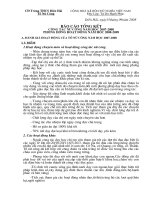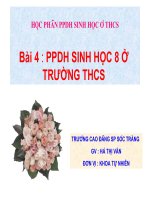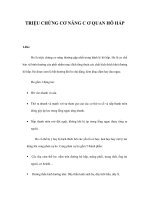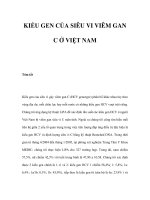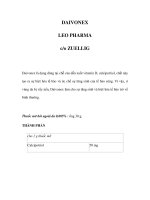22 c o bond forming reactions
Bạn đang xem bản rút gọn của tài liệu. Xem và tải ngay bản đầy đủ của tài liệu tại đây (1.91 MB, 20 trang )
Myers
Williamson Ether Synthesis
Relative Reactivities:
Background
• Relative reactivities of electrophiles, with respect to the alkyl substituent:
• The synthesis of ethyl ether from sodium ethoxide and ethyl iodide was first reported by
Alexander W. Williamson in 1851:
H3C
OH
O Na+
Me, allylic, benzylic > 1º alkyl > 2º alkyl > branched 2º alkyl >> neopentyl, 3º alkyl
• Relative reactivities of electrophiles, with respect to the leaving group:
EtI
Na
H3C
Chem 115
C–O Bond-Forming Reactions: SN2 Reactions
(yield not provided)
H3C
O
CH3
OTf > OTs > OMs
I > Br > Cl
• Trimethyloxonium tetrafluoroborate (Meerwein's salt) is a powerful alkylating agent:
Williamson, W. Liebigs Ann. Chem. 1851, 77, 37!49.
Williamson, W. J. Chem. Soc. 1852, 106, 229–239.
H3C
• Since its original discovery, the Williamson ether synthesis method has become widely used in
both academic and industrial settings.
CH3
O
CH3
BF4
Intramolecular Williamson Ether Synthesis:
Overview
• Relative rates of ring formation:
R OH
base
R O
R'
X
R OR'
Ring size:
3~5>6>4>7>8
Fast
• R = 1º, 2º, and 3º alkyl
allyl, benzyl, aryl, heteroaryl
• X = I, Br, Cl, OSO2R
Slow
• R' = 1º, and 2º alkyl, allyl, benzyl
• Base = alkali metals/NH3(l), metal hydrides
• Proximity effect: in the following intramolecular etherification reaction, successive addition of
methyl groups on the substrate places the electrophile and nucleophile in closer proximity.
LHMDS, LDA, NaOH, KOH, K2CO3, Cs2CO3.
• Solvents: alcohol (alkoxide), DMF, DMSO and HMPA.
O
Mechanism
OMs
CH3
H3C
O
OMs
OMs
H3C CH3
• The reaction proceeds through an SN2 pathway.
Limitations
O
relative
rate of
ether
formation
1
3.5
3 x 103
CH3
H3C
O
OMs
H3C CH3
8.6 x 105
• For hindered substrates, base-catalyzed elimination of the alkylating agent can be problematic.
• For phenoxides, C–alkylation can compete with O–alkylation.
Kirby, A. J. Adv. Phys. Org. Chem. 1980, 17, 183–179.
Anslyn, E. V.; Dougherty, D. A. Modern Physical Organic Chemistry; University Science Books:
Sausalito, CA, 2006; pg 497.
Angela Puchlopek-Dermenci, Alpay Dermenci, Fan Liu
1
Myers
Chem 115
C–O Bond-Forming Reactions: SN2 Reactions
Examples
OCH3
OH
OCH3
O
K2CO3
Br
+
acetone
60 ºC, 98%
NO2
EtO
H3C CH3
NO2
1. t-BuOK, THF
0 ! 5 ºC
CH3
O
2. MsO
N
OH
S
(180 g)
N
CF3
5 ! 18 ºC
Garcia, A. L. L.; Carpes, M. J. S.; de Oca, A. C. B. M.; dos Santos, M. A. G.; Santana, C. C.; Correia,
C. R. D. J. Org. Chem. 2005, 70, 1050–1053.
(232 g)
CH3
O
• For hindered substrates, KH often performs better than NaH.
EtO
H3C CH3
• KH is highly flammable and is supplied commercially as a 30% w/w slurry in mineral oil. In the
examples below, the authors used a 50% by weight homogenate of KH in paraffin, which is
observed to be air stable and operationally more convenient:
O
N
75%
S
(246.5 g)
H3C CH3
OH
CF3
H3C CH3
KH, BnBr
OBn
THF, 23 ºC, 99%
H3C CH3
N
Reuman, M.; Hu, Z.; Kuo, G.-H.; Li, X.; Russell, R. K.; Shen, L.; Youells, S.; Zhang, Y. Org. Process
Res. Dev. 2007, 11, 1010–1014.
• In the following example, etherification proceeds via an epoxide intermediate. Addition of ZnBr2 was
found to promote epoxide opening:
H3C CH3
KH, BnBr
O
O
CH3
THF, 23 ºC, 91%
O
O
OH
CH3
OBn
OH
3.
HO
HO
TsO
H
• Alkyl chlorides can be converted in situ to the more reactive alkyl iodide:
F
N
H3CO
OH
CO2H
K2CO3, BnCl, KI
acetone, 60 ºC, 79%
H3CO
THF, 65 ºC
H
N
O
F
O
CO2H
O
OBn
F
Huang, H.; Nelson, C. G.; Taber, D. F. Tetrahedron Lett. 2010, 51, 3545–3546.
OBn
1. NaH, THF, 5 ºC
2. ZnBr2
F
OBn
Wu, G. G. Org. Process Res. Dev. 2000, 4, 298–300.
Bourke, D. G.; Collins, D. J. Tetrahedron 1997, 53, 3863–3878.
Angela Puchlopek-Dermenci, Alpay Dermenci, Fan Liu
2
Myers
OH
OCH3
OCH3
CH3
NC
• Synthesis of a 5-HT2C receptor agonist :
OCH3
NaH, CH3I
CH3
O
Chem 115
C–O Bond-Forming Reactions: SN2 Reactions
steps
CH3
O
DMF, 0 ºC, 87%
OCH3
CH3
NC
HO
CH3
OCH3
(20 g)
O O
S
OEt
1. K2CO3, EtO
butanone, 110 ºC
CH3
EtO
NO2 2. H2, Pd/C
MeOH, 23 ºC
94% (2 steps)
steps
CH3
NH2•HCl
EtO
NH2
N
(18.6 g)
OCH3
OCH3
Peters, R.; Waldmeier, P.; Joncour, A. Org. Proc. Res. Dev. 2005, 9, 508!512
CH3
H3C
CH3O OH
O
H
N
CH3
• Synthesis of maxacalcitol (Oxarol"), an antihyperparathyroidism and antipsoriatic vitamin D3
analogue:
OH
H
OCH3
O
H3C
O
H3C
Pederin
H3C
TBSO
CH3
Wan, S.; Wu, F.; Rech, J. C.; Green, M. E.; Balachandran, R.; Horne, W. S.; Day, B. W.; Floreancig,
P. E. J. Am. Chem. Soc. 2011, 133, 16668!16679.
OH
H3C
1. NaH, THF, 23 ºC
2.
TBSO
• Synthesis of didemniserinolipid B:
H
Br
(17.2 kg)
OH
H
OH
O
H3C
N
CH3
Boc
+ MsO
O
15
O
NaH, DMSO
86%
H
O
O
H3C
Ph
CH3
CH3
H3C
TBSO
CH3
TBSO
3. L-selectride
O
15
THF, 70 ºC, 99%
H
O
N
CH3
CH3
H O CH3
THF, 70 ºC
OH
H
O
O
Boc
Ph
H3C
H3C
O
OH
steps
steps
OH
O O
S
NaO
O
O
NH2
O
H3C
TBSO
CH3
O
OH
H3C CH3
TBSO
(19.6 kg)
O
15
H3C
H3C CH3
H
HO
OH
Maxacalcitol
EtO2C
didemniserinolipid B
Marvin, C. C.; Voight, E. A.; Burke, S. D. Org. Lett. 2007, 9, 5357!5359.
Shimizu, H.; Shimizu, K.; Kubodera, N.; Mikami, T.; Tsuzaki, K.; Suwa, H.; Harada, K.; Hiraide, A.;
Shimizu, M.; Koyama, K.; Ichikawa, Y.; Hirasawa, D.; Kito, Y.; Kobayashi, M.; Kigawa, M.; Kato, M.;
Kozono, T.; Tanaka, H.; Tanabe, M.; Iguchi, M.; Yoshida, M. Org. Proc. Res. Dev. 2005, 9, 278!287.
Angela Puchlopek-Dermenci, Alpay Dermenci, Fan Liu
3
Myers
Chem 115
C–O Bond-Forming Reactions: Diazoalkane Reagents
• Other acidic functional groups, such as phenols, can also be methylated.
Introduction
• Diazo compounds are uniquely reactive 1,3-dipoles
O
H
OH
H
N N
H
HO
O
O
CH3
N N
H
OH
HO
O
CH3
CH2N2, CH2Cl2
20 ºC, 60%
OH O
• Diazo compounds are toxic and potentially explosive. They covalently modify nucleobases and
thus are mutagens. Consequently, care must be taken when handling these compounds.
OH
H3CO
O
OH
Blade, R. J.; Hodge, P. J. Chem. Soc. Chem. Commun. 1979, 85–86.
• Alcohols are not sufficiently acidic to protonate diazomethane and require a catalyst to react.
Common catalysts include BF3•OEt2, HBF4, SnCl2 and silica gel:
Fulton, J. R.; Aggarwal, V. K.; de Vicente, J. Eur. J. Org. Chem. 2005, 1479–1492.
Esterification and Etherification Using Diazomethane
O
BzO
BzO
OBz
OH
CH2N2, BF3•OEt2
O
BzO
CH2Cl2, 0 ºC, 74%
BzO
OBz
OCH3
Sammakia, T. Diazomethane in Encyclopedia of Reagents for Organic Synthesis.
Chavis, C.; Dumont, F.; Wightman, R. H.; Ziegler, J. C.; Imbach, J. L. J. Org. Chem. 1982, 47, 202!206.
• Diazomethane is one of the most effective reagents for the preparation of methyl esters from
carboxylic acids. The carboxylic acid protonates the diazomethane reagent to generate a
diazonium-carboxylate ion pair, which collapses to form the methyl ester.
Preparation of Diazomethane
• Diazomethane is prepared by the decomposition of a variety of N-methyl-N-nitrosoamines and is
obtained most often as a solution in ethyl ether.
• Products can typically be isolated by simple evaporation of the volatile ethereal solvent (ethereal
solutions of diazomethane are obtained by distillation using special fire-polished glassware, to
prevent explosion). Diazomethane itself is highly volatile (bp = –23 ºC).
O
OBn OBn
OBn
HO
OBn OBn
O
CH2N2, Et2O
23 ºC, 70%
• The example below utilizes N–methyl-N-nitroso-p-toluenesulfonamide (Diazald").
OBn OBn
OBn
H3CO
OBn OBn
H3C
O O
N
S
N
O
CH3
KOH
EtO
O
H2C N N
OH
Et2O, H2O, 65 ºC
Schmidt, R. R.; Frick, W. Tetrahedron 1988, 44, 7163–7169.
Hudlicky, M. J. Org. Chem. 1980, 45, 5377–5378.
de Boer, T. J.; Backer, H. J.; Org. Synth. 1963, 4, 250–253.
Fan Liu
4
Myers
Chem 115
C–O Bond-Forming Reactions: Diazoalkane Reagents
• Reaction set-up:
• The reaction proceeds through in situ generation of the active methylating agent, diazomethane.
O
Dropping funnel
containing
(Diazald")
distillation apparatus
R
OH
+
O
TMS
N N
R
TMS
+
O
N N
Receiving flask
containing a solution
of CH2N2 in Et2O,
cooled to –15 ºC
special joints, NOT
ground-glass
O
OH
EtO
KOH, H2O, Et2O
heated to 65 ºC
CH3OH
O
O
R
R
OCH3
+
OH
N2
H2C N N
+
TMSOCH3
• Kits can be purchased which include non-ground glassware to decrease the likelihood of
diazomethane explosion.
• Leftover diazomethane should be quenched with dilute acetic or oxalic acid.
Kühnel, E.; Laffan, D. D. P.; Lloyd-Jones, G. C.; Martinez del Campo, T.; Shepperson, I. R.; Slaughter,
J. L. Angew. Chem. Int. Ed. 2007, 46, 7075–7078.
• If a pipette is to be used to transfer diazomethane, it must be fire polished first.
• Diazomethane is one of the most dangerous diazo compounds because of its volatility and
propensity to detonate. All operations should be conducted behind a blast shield and care must be
taken when handling this compound.
• Enols can also be methylated:
Hudlicky, M. J. Org. Chem. 1980, 45, 5377–5378.
de Boer, T. J.; Backer, H. J.; Org. Synth. 1963, 4, 250–253.
O
H3CO
Trimethylsilyldiazomethane
H3C
O
O
O
Shioiri, T.; Aoyama, T. Trimethylsilyldiazomethane in Encyclopedia of Reagents for Organic Synthesis.
H
N
OH
O
N
H
CH3
TMSCHN2
toluene, MeOH
25 ºC, 90%
O
H3C
• Because of the high volatility and toxicity of diazomethane, the safer, less volatile reagent,
trimethylsilyldiazomethane is often used, solutions of which are commercially available.
O
CH3 O
TBSO
CH3 O
TMSCHN2
OH
C6H6, MeOH
0 # 25 ºC, >69%
TBSO
H3CO
OCH3
H3C
O
O
O
H
N
OCH3
O
N
H
CH3
O
H3C
Evans, M. A.; Morken, J. P. Org. Lett. 2005, 7, 3371–3373.
Coleman, R. S.; Tierney, M. T.; Cortright, S. B.; Carper, D. J. J. Org. Chem. 2007, 72, 7726!7735.
Fan Liu
5
Myers
Chem 115
C–O Bond-Forming Reactions: Diazoalkane Reagents
Esterification and Etherification Using Phenyldiazomethane
Sammakia, T. Phenyldiazomethane in Encyclopedia of Reagents for Organic Synthesis.
OH
OBn
H3C
N
O
HO
H3C
OH
H
O
O
O
PhCHN2, Et2O
OCH3
CH3
H
N
O
HO
H3C
20 ºC, >85%
OBn
H
O
O
O
O
Goulet, M. T.; Boger, J. Tetrahedron Lett. 1990, 31, 4845–4848.
PhCHN2, HBF4 (cat)
H
PhCHN2, HBF4 (cat)
SO2Ph
SO2Ph
Bachi, M. D.; Korshin, E. E.; Hoos, R.; Szpilman, A. M.; Ploypradith, P.; Xie, S.; Shapiro, T. A.;
Posner, G. H. J. Med. Chem. 2003, 46, 2516–2533.
• Neat phenyldiazomethane is commonly prepared by vacuum pyrolysis of the sodium salt of
benzaldehyde tosylhydrazone:
OBn
CH2Cl2, –40 ºC, 81%
N
O
O
H3C
CH2Cl2, –30 ºC, 86%
Preparation of Phenyldiazomethane
• HBF4 can be used as an acid catalyst for the benzylation of alcohols and amines using
phenyldiazomethane. Amines react more slowly under these conditions:
OH
H3C
OCH3
CH3
H
O
PhCHN2, TfOH (30 mol%)
O
O
H3C
N
Ph
N
Bn
Ts
N
1. NaOCH3
H
H
N
CH3OH, 23 ºC
Ph
Ts
N
Na
H
2. evaporate and dry
90 ! 220 ºC
vacuum
76–80 ºC
N2
Ph
H
Creary, X. Org. Synth. 1990, 7, 438–443.
CH2Cl2, 0 ! 23 ºC, 60%
• Alternatively, phenyldiazomethane can be prepared by dehydrogenation of benzaldehyde
hydrazone using Swern-like conditions:
NH2+BF4–
OH
1. PhCHN2, HBF4 (cat)
CH2Cl2, –40 ºC
2. basic work-up, 68%
Liotta, L. J.; Ganem, B. Tetrahedron Lett. 1989, 30, 4759–4762.
NH2+BF4–
OBn
N
Ph
NH2
H
1. (COCl)2, DMSO
Et3N, THF, –78 ºC
2. filtration of Et3N•HCl
N2
H
Ph
(solution in THF)
Javed, M. I.; Brewer, M. Org. Lett. 2007, 9, 1789–1792.
Wommack, A. J.; Moebius, D.; Travis, A.; Kingsbury, J. S. Org. Lett. 2009, 11, 3202–3205.
Fan Liu
6
Myers
Chem 115
C–O Bond-Forming Reactions: Diazoalkane Reagents
• More complex esterification reagents can be generated by in situ oxidation of their corresponding
N-tert-butyldimethylsilylhydrazones with (difluoroiodo)benzene:
• Diazoalkanes can also be generated in situ from the corresponding tosyl hydrazone at high
temperature:
NO2
H
O
H
N N
H
TBS
TBS
O
H
O
OBz
H
O
I
Ph
N
HO
F ,
OBz
O
H
O
O
O
110 ºC,
O
CH3
CH3
Ts
N
H
CH3
OBz
HO
Ph
CH3
µwave, 155 ºC
H3C
Ph
O
K2CO3, PhF
+
72%
H3CO
HO
N
OBz
N2
NO2
H3CO
N2
H
O
84%
K2CO3, dioxane
H
H3CO
2-chloropyridine
CH2Cl2, –78 " 23 ºC
NO2
Ts
N
CH3
H
O
NO2
O
F
H
O
Sc(OTf)3 (0.01 mol%)
0 " 23 ºC, >95%
TBS
N
N
H
H3C
74%
Barluenga, J.; Tomas-Gamasa, M.; Aznar, F.; Valdes, C. Angew. Chem. Int. Ed. 2010, 122, 5113–5116.
Rhodium-Mediated Etherification Reactions
TBS
N
N
H
H3CO
H3CO
H
NO2
Reviews:
F
Ph
I
+
HO
H3C
OH
O
CO2H
Valdes, C.; Barluenga, J. Angew. Chem. Int. Ed. 2011, 50, 7486–7500
Fulton, J. R.; Aggarwal, V. K.; de Vicente, J. Eur. J. Org. Chem. 2005, 1479–1492.
F
O
2-chloropyridine
CH2Cl2, –78 " 23 ºC
• Diazo compounds bearing an electron-withdrawing group are considered much safer than
diazomethane because of resonance stabilization by the electron-withdrawing group. In addition,
stabilized diazo compounds tend to much less volatile.
82%
• Treatment of simple !-diazoketones in aqueous acids provides the corresponding alcohols.
O
HO
H3C
OH
OO
O
OCH3
O2N
Furrow, M. E.; Myers, A. G. J. Am. Chem. Soc. 2004, 126, 12222–12223.
Furrow, M. E.; Myers, A. G. J. Am. Chem. Soc. 2004, 126, 5436–5445.
OCH3
O
N2
MeS
F
aq. HCl, acetone
40 ºC, 62%
O
MeS
OH
F
Pirrung, M. C.; Rowley, E. G.; Holmes, C. P. J. Org. Chem. 1993, 58, 5683–5689.
Fan Liu
7
Myers
• Ethyl diazoacetate can be deprotonated with LDA at low temperature. The resulting anion can be
trapped with electrophiles.
O
H
Chem 115
C–O Bond-Forming Reactions: Diazoalkane Reagents
O
LDA, THF, –90 ºC
Li
OEt
N2
H3C
O
H3C
OEt
–75 ºC, THF
N2
Reviews:
Heydt, H. Sci. Synth. 2004, 27, 843–937.
OH
O
O
Synthesis of Diazo Compounds
N2
51%
• In addition to the methods described above for the generation of reactive diazo reagents, diazo
compounds can be prepared by the following methods:
CO2Et
• Regitz Diazo Transfer Reaction
• Rhodium catalysts readily transform "-diazoesters into stabilized carbenoids, which readily
etherify alcohols:
• Reaction of an enolate with sulfonyl azide affords diazo compounds:
OH
O
H3C
N2
Rh2OAc4 (1 mol%)
C6H6, 80 ºC, 80%
CO2Et
O
H3C
O
CO2Et
O
H3CO
O
O O
S
N3
+
CH3
K2CO3, MeCN
O
23 ºC, 96%
H3CO
OH
N2
O
Rh2OAc4 (1 mol%)
CO2Et
C6H6, 80 ºC, 77%
O
O
C6H13
CO2Et
Koskinen, A. M. P.; Munoz, L. J. Chem. Soc. Chem. Commun. 1990, 652–653.
• Formation of medium-sized rings is entropically unfavorable and competitive C–H insertion by the
rhodium carbenoid is observed:
OEt
O
Rh2OAc4 (5 mol%)
C6H6, 80 ºC, 77%
O
O
O
OH
N2
OH
+
H3C
CH3
(120 equiv)
Rh2OAc4 (1 mol%)
CH2Cl2, 23 ºC, 92%
O
O
O
1. NaHMDS, –78 ºC
N
Ph
N2
2. PNBSA, 85–87%
Bn
69%
O
Bn
• The above reaction is highly sensitive to the enolate counterion, the quenching reagent, and the
sulfonyl azide structure: using triisopropylsulfonyl azide (trisyl azide) instead led to selective azide
transfer.
• Intermolecular trapping is also possible:
CO2Et
N
Ph
CO2Et
Moody, C. J.; Taylor, R. J. J. Chem. Soc. Perkin Trans. 1 1989, 721–731.
O
O
CO2Et
+
12%
Ph
• p-nitrobenzenesulfonyl azide (PNBSA) was found to be an effective diazo transfer agent for
carboximide enolates:
O
N2
OH
CH3
N2
H3C
C6H13
O
Ph
CO2Et
O
CH3
CH3
Cox, G. G.; Miller, D. J.; Moody, C. J.; Sie, E.-R. H. B.; Kulagowski, J. J. Tetrahedron 1994, 50, 3195!
3212.
O
O
Ph
N
Bn
O
O
O
1. KHMDS, –78 ºC
2. Trisyl-N3
3. AcOH, 25 ºC
N
Ph
N3
91%
O
Bn
Evans, D. A.; Britton, T. C.; Ellman, J. A.; Dorow, R. L. J. Am. Chem. Soc. 1990, 112, 4011–4030.
Fan Liu
8
Myers
C–O Bond-Forming Reactions: Diazoalkane Reagents
Chem 115
• When only one electron-withdrawing group is present on the substrate, a second electronwithdrawing group is usually introduced to activate the parent compound towards diazo transfer.
The second electron-withdrawing group is removed at the end of the reaction:
O
O
F3C
CH3
O
OCH2CF3
1.
O
F3C
O
MsN3, Et3N
CF3
LiHMDS, THF, –78 ºC
S
O
N2
H2O, CH3CN
25 ºC, 92%
S
O
S
O
OCH2CF3
LiHMDS, THF, –78 ºC
2. MsN3, Et3N
N2
H2O, CH3CN
25 ºC, 81%
Danheiser, R. L.; Miller, R. F.; Brisbois, R. G.; Park, S. Z. J. Org. Chem. 1990, 55, 1959–1964.
• Reaction of acyl chlorides or anhydrides with diazomethane yields diazo compounds:
H3C
H
HO2C
H3C
CH3
H
CH3
CH3
CH3
H
1. (COCl)2, C6H6
2. CH2N2, 23 ºC
>78%
N2
O
H
CH3
CH3
Smith, A. B.; Dorsey, B. D.; Visnick, M.; Maeda, T.; Malamas, M. S. J. Am. Chem. Soc. 1980, 108,
3110–3112.
• Diazotization of primary amines also affords diazo compounds:
OEt
H2N
•HCl
O
NaNO2, NaOAc
H2SO4 (cat), H2O
OEt
N2
O
0 ºC, >70%
Wuzr, R. P.; Charett, A. B. Org. Lett. 2002, 4, 4531–4533.
Fan Liu
9
Myers
Metal-Catalyzed C!O Bond-Forming Reactions: Buchwald!Hartwig Coupling
Chem 115
Reviews:
Initial Reports:
Hartwig, J. F. Organotransition Metal Chemistry, 1st Edition; University Science Books: USA,
• Buchwald and co-workers reported an intramolecular C-O coupling procedure following a
mechanism similar to that of Pd-catalyzed amination. Bidentate phosphine ligands afford high
conversions to product.
2009.
Condition A:
Frlan, R.; Kikelj, D. Synthesis, 2006, 14, 2271!2285.
Schlummer, B.; Scholz, U. Adv. Synth. Cat. 2004, 346, 1599!1626.
Reaction Highlights
X
• The main challenge in the Pd-catalyzed C-O bond forming reactions is to prevent "-H elimination
of the alcohol substrate. Many factors, including Pd source, ligand, base, solvent, and
temperature can influence the efficiency of the reaction.
CH3
CH3
OH
Pd(OAc)2 (5 mol%)
Tol-BINAP (6 mol%)
K2CO3 (1.2 equiv)
toluene, 100 °C
X: Br or I
CH3
CH3
O
60%
89%
I:
Br:
Condition B:
• Much of the improvement in this field has come from the development of ligands, which permits
couplings of substrates with varying steric and electronic parameters.
OH
CH3
CH3
• The development of ligands has also improved the reactivity of unactivated aryl halides.
Pd(OAc)2 (3 mol%)
dppf (3.6 mol%)
NaOt-Bu (1.2 equiv)
O
toluene, 80 °C
Br
CH3
CH3
69%
General Mechanism
Condition C:
O
Ar
Pd(OAc)2 (5 mol%)
dppf (10 mol%)
NaOt-Bu (2.0 equiv)
OH
R1
R2
LnPd
Ar!X
toluene, 90 °C
Br
R2
R1
Ln Pd H
Ar
elimination
Ln Pd Ar
X
R2
O
H
Pd
Ar
Ln
R1
HO
LnPd
O
+
+
R1
R2
ArH
Base•HX
Base
Ln Pd Ar
X
R2
Palucki, M.; Wolfe, J. P.; Buchwald, S. L. J. Am. Chem. Soc. 1996, 118, 10333!10334.
• Electron-deficient aryl bromides were found to be more reactive than electron-neutral and
electron-rich aryl bromides.
R1
HO
H
Condition A (24!36 h) gives product cleanly while Condition B gives product with a faster
reaction rate (1!6 h). Condition C works well for secondary alcohols.
R1
"-H
O
66%
reductive
elimination
O
H
R2
O
+
Br
Pd(dba)2 (10 mol%)
dppf (12 mol%)
O
NaOt-Bu
(1.2 equiv)
100 °C, toluene
Ot-Bu
69%
Mann, G.; Hartwig, J. F. J. Am. Chem. Soc. 1996, 118, 13109!13110.
Alpay Dermenci
10
Myers
Chem 115
Metal-Catalyzed C"O Bond-Forming Reactions: Buchwald"Hartwig Coupling
• The methodology was extended to intermolecular cross-coupling with primary and secondary
alcohols.
Pd2(dba)3 (1.5 mol%)
Tol-BINAP (3.6 mol%)
X
+
R1
R2OH
• Ligands and Their Applications
• A series of ligands developed by Buchwald and co-workers improved reactivities of a combination of
substrates, including unactivated aryl halides and triflates.
OR2
P(t-Bu)2
P(t-Bu)2
toluene, !
R1
(1.2 equiv)
Ligand A
Aryl halide
Alcohol
Br
Product
O
OH
H3C
NC
CH3
CH3
CH3
NC
Temp (°C)
Yield (%)a
50
80 (76)
Ligand B
X
Pd(OAc)2 (2.0 mol%)
Ligand (3 mol%)
K3PO4 (2.0 mol%)
HO
+
(1.2 equiv)
CH3
CH3
i-Pr
NC
70
O
i-Pr
OH
77 (73)
Aryl halide
Phenol
Br
NC
HO
H3C
Br
100
Ligand
OH
Product
CH3
O
A
OTf
CH3
96 (95)a
H3C
HO
i-Pr
O
B
i-Pr
84
t-Bu
O
70
65 (<5)
Br
H3C
H3C
HO
O
83
C
CH3
aValues
Yield (%)
O
t-Bu
Br
R
53 (<10)
t-Bu
t-Bu
O
toluene, 100 °C
14"24 h
O
Ot-Bu
NaOt-Bu
Ligand C
Biaryl Ether Synthesis
R
Br
P(t-Bu)2
Ph
(H3C)2N
CH3
in parentheses are yields with no catalyst (DMF as solvent).
aReaction
Palucki, M.; Wolfe, J. P.; Buchwald, S. L. J. Am. Chem. Soc. 1997, 119, 3395"3396.
run with 0.1 mol% Pd(OAc)2, 0.15 mol% ligand.
Aranyos, A.; Old, D. W.; Kiyomori, A.; Wolfe, J. P.; Sadighi, J. P.; Buchwald, S. L. J. Am. Chem. Soc.
1999, 121, 4369"4378.
Kuwabe, S.-i.; Torraca, K. E.; Buchwald, S. L. J. Am. Chem. Soc. 2001, 123, 12202"12206.
Alpay Dermenci
11
Myers
Chem 115
Metal-Catalyzed C!O Bond-Forming Reactions: Buchwald!Hartwig Coupling
• It was discovered that binaphthyl ligands such as D and E can improve reactivity and yield and
allow for the intermolecular coupling of primary alcohols and aryl halides with minimal arene
reduction.
Intramolecular Synthesis of Cyclic Aryl Ethers
Substrate
P(t-Bu)2
N(CH3)2
Product
Temp. (oC)
OH
P(t-Bu)2
H
50
Aryl halide
Cl
H3C
CH3
Ligand E
Alcohol
(2 equiv)
n-BuOH
PhCH2OH
i-BuOH
EtOH
Product
OR
H3C
CH3
H3CO
Ligand
Yield (%)
E
E
E
E
90
95
88
93
71
O
Cl
Ligand D
Yield (%)
H3CO
OH
50
71
Br
O
OH
70
74
O
Cl
Conditions: Pd(OAc)2 (2–3 mol%), ligand E (2.5–3.5 mol%), Cs2CO3, toluene.
Cl
n-BuO
n-BuOH
E
88
Application to the Synthesis of MKC-242
HO
n-BuOH
Cl
N
E
n-BuO
Br
N
O
O
O
Br
Pd(OAc)2 (3 mol%)
Ligand A (3.5 mol%)
K3PO4 (1.5 mol%)
toluene, 70 oC
90 h
OR
n-BuOH
PhCH2OH
D
D
OCH3
80
80
OCH3
O
O
Br
CH3
N
O
79
O
N
Boc
n-BuOH
n-BuO
N
Boc
D
72
Torraca, K. E.; Huang, X.; Parrish, C. A.; Buchwald, S. L. J. Am. Chem. Soc. 2001, 123, 10770!
10771.
H
N
MKC-242
(antidepressant)
O
O
O
O
O
CH3
N
O
O
94%
O
O
Torraca, K. E.; Kuwabe, S.-I.; Buchwald, S. L. J. Am. Chem. Soc. 2000, 122, 12907!12908.
Kuwabe, S.-i.; Torraca, K. E.; Buchwald, S. L. J. Am. Chem. Soc. 2001, 123, 12202!12206.
Alpay Dermenci
12
Myers
Chem 115
Metal-Catalyzed C!O Bond-Forming Reactions: Buchwald!Hartwig Coupling
• The substrate scope was expanded to include secondary, allylic and propargylic alcohols with
ligands F and G.
CH3
H3C
CH3
H3C
CH3
P(t-Bu)2
CH2t-Bu
H3C
• (CH3)4-t-BuXPhos and RockPhos allow for improved coupling of aryl halides with phenols and
secondary/primary alcohols, respectively.
CH3
P(t-Bu)2
i-Pr
H3C
Ligand F
CH3
OCH3
H3C
CH3
H3C
i-Pr
Pt-Bu2
i-Pr
Ligand G
i-Pr
i-Pr
Cl
HO
+
n-Bu
(CH3)4-t-BuXPhos
Pd(OAc)2 (2 mol%)
Ligand F (2.4 mol%)
CH3
Cs2CO3 (1.5 equiv)
Bu3N, 100 °C, 70%
CH3
(2 equiv)
O
CH3
n-Bu
Cl
N
Pd(OAc)2 (2 mol%)
Ligand G (2.4 mol%)
HO
Br
+
CH3
H3C
Cs2CO3 (1.5 equiv)
toluene, 70 °C, 90%
Pd(OAc)2 (2 mol%)
(CH3)4-t-BuXPhos (3 mol%)
HO
+
K3PO4, toluene, 100 °C, 91%
O
Cl
+
• This methodology can be used in conjunction with Cu-mediated Ullman-type couplings (discussed in
that chapter).
[allylPdCl)2] (0.5 mol%)
RockPhos (1.5 mol%)
HO
O
N
(2 equiv)
I
CuI (10 mol%)
1,10-phenanthroline (20 mol%)
Br
+
Cs2CO3, i-PrOH, 110 °C
81%
H3C
O
Oi-Pr
H3C
CH3
H3C
Oi-Pr
O
CH3
(2 equiv)
Br
OPh
N
H3C
(1.2 equiv)
O
CH3
CH3
RockPhos
CH3
H3C
H3C
Pt-Bu2
i-Pr
H3C
i-Pr
4Å MS, Cs2CO3
Bu3N, 90 °C, 72%
O
O
N
OH
H3C
CH3 (2 equiv)
Boc
Br
+
Pd (OAc)2 (3 mol%)
Ligand F (3.6 mol%)
Cs2CO3, Bu3N, 50 °C
84%
Vorogushin, A. V.; Huang, X.; Buchwald, S. L. J. Am. Chem. Soc. 2005, 127, 8146!8149.
N
HO
[allylPdCl)2] (0.5 mol%)
RockPhos (1.5 mol%)
Boc
N
O
Cs2CO3, toluene, 90 °C
(3 equiv)
98.5% ee
86%, 98.5% ee
Burgos, C. H.; Barder, T. E.; Huang, X.; Buchwald, S. L. Angew. Chem. Int. Ed. 2006, 45, 4321!
4326.
Wu, X.; Fors, B. R.; Buchwald, S. L. Angew. Chem. Int. Ed. 2011, 50, 9943!9947.
Alpay Dermenci
13
Myers
Chem 115
Metal-Catalyzed C!O Bond-Forming Reactions: Buchwald!Hartwig Coupling
• The superiority of these ligands stems from their effectiveness in promoting reductive elimination.
• Ph5FcP(t-Bu)2 was later found to be a superior ligand, while substituting the ferrocene ring with
electron-donating substituents was found to increase both the reaction rate and yields.
locked
P(t-Bu)2
t-Bu Ar
t-Bu
P Pd OAr
H3C
i-Pr
i-Pr
H3C
rotatable
t-Bu Ar
t-Bu
P Pd OAr
i-Pr
i-Pr
Fixes PdII over the
triiisopropyl ring
H3C
CH3 i-Pr
CH3
X = Cl or Br
OCH3
toluene, 80 °C
(1.2 equiv)
Ar
Ar = p-MeOC6H4: (p-MeOPh)5FcP(t-Bu)2
Ar = p-CF3C6H4: (p-CF3Ph)5FcP(t-Bu)2
Br
Pd(dba)2 (5 mol%)
Ph5FcP(t-Bu)2 (5 mol%)
NaO
+
CH3
OCH3
(1.2 equiv)
O
CH3
toluene, 23 °C, 70 h
99%
OCH3
Pd(dba)2 (5 mol%)
Ph5FcP(t-Bu)2 (5 mol%)
OH
CH3
CH3
• Hartwig and co-workers discovered that the sterically hindered FcP(t-Bu)2 promotes reductive
elimination and formation of diaryl ethers from unactivated aryl halides.
Pd(dba)2 (2-5 mol%)
FcP(t-Bu)2 (2-5 mol%)
Ar
Ar
conformationally rigid
• Hartwig Ligands
NaO
Ar
Ph
Ph5FcP(t-Bu)2
CH3 i-Pr
+
Fe
Ph
i-Pr
X
P(t-Bu)2
Ar
Ph
Ph
t-Bu Ar
t-Bu
P Pd OR
H3CO
i-Pr
i-Pr
Fe
Ph
Br
toluene, 23 °C, 10 min
93%
O
Pd(dba)2 (5 mol%)
(p-MeOPh)5FcP(t-Bu)2
(7.5 mol%)
O
CH3
CH3
O
CH3
Br
OCH3
X = Cl, 82%
X = Br, 85%
NaO
+
H3C
OCH3
(1.2 equiv)
toluene, 80 °C, 3 h
91%
H3C
OCH3
FcP(t-Bu)2 = ferrocenyldi-tert-butylphosphine
P(t-Bu)2
Br
Fe
Pd(dba)2 (5 mol%)
(p-CF3Ph)5FcP(t-Bu)2
(7.5 mol%)
NaO
+
H3C
OCH3
(1.2 equiv)
Mann, G.; Incarvito, C.; Rheingold, A. L.; Hartwig, J. F. J. Am. Chem. Soc. 1999, 121, 3224!3225.
toluene, 80 °C, 18 h
29%
O
H3C
OCH3
Shelby, Q.; Kataoaka, N.; Mann, G.; Hartwig, J. J. Am. Chem. Soc. 2000, 122, 10718!10719.
Kataoka, N.; Shelby, Q.; Stambuli, J. P.; Hartwig, J. F. J. Org. Chem. 2002, 67, 5553!5566.
Alpay Dermenci
14
Myers
Chem 115
Metal-Catalyzed C!O Bond-Forming Reactions: Buchwald!Hartwig Coupling
• Other Ligands
• Primary alcohols are selectively coupled in the presence of secondary alcohols:
• In addition to ligands developed by Buchwald and Hartwig, Singer and co-workers have developed
a structurally different ligand, bippyphos (prepared on multi-kilogram scale), which allows coupling
of aryl halides and alcohols.
OH
Br
OH
H3C
+
N
N
N
N
Pd2(dba)3 (0.5 mol%)
bippyphos (2 mol%)
N
CH3
HO
(3 equiv)
N
MeOH, 65 ºC, 100%
Cl
P(t-Bu)2
Pd(OAc)2 (1 mol%)
Ligand (2 mol%)
O
CH3
H3C
Cs2CO3, toluene
80 °C, 69%
regioselectivity >99%
OCH3
Gowrisankar, S.; Sergeev, A. G.; Anbarasan, P.; Spannenberg, A.; Neumann, H.; Beller, M. J. Am.
Chem. Soc. 2010, 132, 11592!11598.
bippyphos
• Application to synthesis of butoxycaine, a local anesthetic:
Singer, R. A.; Caron, S.; McDermott, R. E.; Arpin, P.; Do, N. M. Synthesis, 2003, 1727–1731.
Withbroe, G. J.; Singer, R. A.; Sieser, J. E. Org. Proc. Res. Dev. 2008, 12, 480!489.
• Beller and co-workers have developed a modified bippyphos ligand that is effective for the coupling
of aryl halides with primary and secondary alcohols.
O
OCH3
OCH3
O
OH
LiOH, CH3OH
H2O, 60 °C
n-BuOH (3 equiv)
toluene, 80 °C
Br
Ph
O
Pd(OAc)2 (1 mol%)
Ligand (2 mol%)
Cs2CO3
n-BuO
74% (2 steps)
n-BuO
N N
Ph
Ph
N
Br
+
OCH3
n-BuOH
(3 equiv)
N
P(1-adamantyl)2
Pd(OAc)2 (1 mol%)
Ligand (2 mol%)
Cs2CO3, toluene
80 °C, 76%
CH3
O
n-BuO
O
OCH3
H3C
N
CH3
HOCH2CH2N(CH2CH3)2
DCC, DMAP
CH2Cl2, 23 ºC, 72%
O
Butoxycaine
Harkal, S.; Kumar, K.; Michalik, D.; Zapf, A.; Jackstell, R.; Rataboul, F.; Riermeier, T.; Monsees, A.;
Beller, M. Tetrahedron Lett. 2005, 46, 3237!3240.
Alpay Dermenci
15
Myers
Chem 115
Metal-Catalyzed C!O Bond-Forming Reactions: Ullman Coupling
Reviews
Generalized Cross-Coupling:
Rao, K. S.; Wu, T. S. Tetrahedron 2012, 68, 7735!7754.
Evano, G.; Blanchard, N.; Toumi, M. Chem. Rev. 2008, 108, 3054!3131.
Ley, S. V.; Thomas, A. W. Angew. Chem. Int. Ed. 2003, 42, 5400!5449.
Sawyer, J. S. Tetrahedron 2000, 56, 5045!5065.
R OR'
General Reaction Features:
Original Report (Ullman, 1904):
• Good functional group compatibility.
• A base is often required.
• Mild reaction conditions.
• Typically an excess of one of the coupling partners is
necessary.
"Cu"
HO
CuI
HOR'
X = I, Br, B(OH)2, BF3–K+
Kunz, K.; Scholz, U.; Ganzer, D. Synlett, 2003, 15, 2428!2439.
X
+
RX
O
+
Ullman Coupling with Aryl Halides
• A general procedure was reported for the coupling of aryl bromides and iodides with phenols:
X
Ullman, F. Ber. 1904, 37, 853!854.
HO
Ullman, F.; Sponagel, P. Ber. 1905, 38, 2211!2212.
R2
R1
Mechanism: The mechanism for the Ullman arylation of alcohols is not well understood. It is
likely that the reaction involves a CuI species.
X
oxidative
addition
O
reductive
elimination
X
Aryl halide
Phenol
I
HO
CO2H
Br
CuIII L
O
CH3
H3C
O
HO
CH3
CH3
90%
CH3
CO2H
O
CH3
84%
CH3
CH3
2.0 equiv
OCH3
Br
Yield (%)
CH3
1.4 equiv
CuIII L
OH
R2
R1
Product
CH3
CH3
X
X
O
Cs2CO3, toluene, 110 °C
H3C
X-CuI
(CuOTf)2•PhH (2.5 mol%)
EtOAc (5 mol%)
OCH3
O
HO
CH3
79%a
CH3
2.0 equiv
a1-naphthoic
acid and 5Å molecular sieves were added.
Litvak, V. V.; Shein, S. M. Zh. Org. Khim. 1975 11, 92!96.
Ley, S. V.; Thomas, A. W. Angew. Chem. Int. Ed. 2004, 43, 5400!5449.
Marcoux, J.-F.; Doye, S.; Buchwald, S. L. J. Am. Chem. Soc. 1997, 119, 10539!10540.
Angela Puchlopek-Dermenci, Alpay Dermenci
16
Myers
Chem 115
Metal-Catalyzed C!O Bond-Forming Reactions: Ullman Coupling
Synthesis of Alkoxy Aryl Ethers
Ullman Coupling with Boronic Acids:
CuI (10 mol%)
1,10-phenanthroline
(20 mol%)
NH2
I
n-BuOH, Cs2CO3
110 °C, 71%
I
CuI (10 mol%)
1,10-phenanthroline
(20 mol%)
• Chan, Lam, and Evans have reported milder conditions for the synthesis of diaryl ethers using
boronic acids and stoichiometric amounts of copper acetate at room temperature.
NH2
CH3
OH
O
(HO)2B
I
OCH3
CH3
+
HO
I
Ph
(2 equiv)
99% ee
Cu(OAc)2 (1 equiv)
O
Cl
F
Et3N, CH2Cl2
23 ºC, 78%
I
F
2 equiv
78%
O
n-BuOH, Cs2CO3
110 ºC, 87%
N
Cl
+
CH3
N
CuI (10 mol%)
1,10-phenanthroline
(20 mol%)
Chan, D. M. T.; Monaco, K. L.; Wang, R.-P.; Winters, M. P. Tetrahedron Lett. 1998, 39, 2933!2936.
OCH3
(HO)2B
CH3
toluene, Cs2CO3
110 °C, 89%
N
NH
Cu(OAc)2 (1.5 equiv)
+
CF3
Ph
O
98% ee
2 equiv
N
N
C6H5N, CH2Cl2
air, 23 ºC, 71%
CF3
Wolter, M.; Nordmann, G.; Job, G. E.; Buchwald, S. L. Org. Lett. 2002, 4, 973!976.
Lam, P. Y. S.; Clark, C. G.; Saubern, S.; Adams, J.; Winters, M. P.; Chan, D. M. T.; Combs, A.
Tetrahedron Lett. 1988, 39, 2941–2944.
Synthesis of Aryl Vinyl Ethers
ligand:
• Evans and co-workers employed a method involving coupling of boronic acids en route to
thyroxine.
O
N
OCH3
CH3
+
Br
Ph
(1.5 equiv)
9:1 E/Z
OH
(1.5 equiv)
I
EtO
AcHN
CH3
OTBS
+
OH
(HO)2B
I
Ph
O
110 ºC, 81%
OH
F
CuI (25 mol%)
Ligand (25 mol%)
Cs2CO3, toluene
O
Cu(OAc)2 (1 equiv)
pyridine, Et3N
CH2Cl2, 25 ºC, 84%
3 equiv
9:1 E/Z
I
Ph
110 ºC, 71%
I
O
CuI (25 mol%)
Ligand (25 mol%)
Cs2CO3, toluene
HO
O
NH2
F
O
I
OH
O
I
I
Ph
Wan, Z.; Jones, C. D.; Koenig, T. M.; Pu, Y. J.; Mitchell, D. Tetrahedron Lett. 2003, 44, 8257!
8259.
I
EtO
AcHN
OTBS
O
I
thyroxine
Evans, D. A.; Katz, J. L.; West, T. R. Tetrahedron Lett. 1998, 39, 2937!2940.
Angela Puchlopek-Dermenci, Alpay Dermenci
17
Myers
Chem 115
Metal-Catalyzed C!O Bond-Forming Reactions: Ullman Coupling
Carboxylic Acids
Ullman Coupling with potassium organotrifluoroborate salts ––– Batey Modification
• Coupling of phenyl boronic acid with a wide range of carboxylic acids occurs in the presence of
• Aryltrifluoroborates are more robust, more easily purified, and less prone to protodeboronation than
urea as an additive:
aryl boronic acids.
• This procedure is effective for coupling both aliphatic alcohols and phenols at room temperature
under pH-neutral conditions.
O
Ar
OH
Cu(OTf)2 (40 mol%)
urea (1.0 equiv)
PhB(OH)2
+
O
Ar
EtOAc, 60 °C, air
(3 equiv)
Cu(OAc)2•H2O (10 mol%)
DMAP (20 mol%)
OPh
ArBF3–K+
+
HOR
Ar OR
CH2Cl2, 4Å MS; O2, 23 ºC
(2 equiv)
O
O
OPh
CH3
O
OPh
H3C
94%
OPh
H3CO
88%
64%
I
78%
O
96%
HO
Ph
Ph
HO
Br
89
Br
O
93
OAc
51%
88%
O
OPh
98%
HO
H3CO
O
N
Ot-Bu
CH3
OPh
95%
O
O
BF3K
O
O
Yield
OPh
OH
OPh
BF3K
O
OPh
O
OPh
89%
O
78%
Product
O
63%
OPh
86%
Phenol/Alcohol
BF3K
60%
Br
Cl
Borate salt
O2N
O
OPh
OPh
OPh
OPh
NC
O
O
O
O
HO
N
Ot-Bu
CH3
93
H3CO
O
O
BF3K
O
99
Zhang, L.; Zhang, G.; Zhang, M.; Cheng, J. J. Org. Chem. 2010, 75, 7472!7474.
HO
H3C
BF3K
O
H3C
O
O
55
Quach, T. D.; Batey, R. A. Org. Lett. 2003, 5, 1381!1384.
Angela Puchlopek-Dermenci, Alpay Dermenci
18
Myers
Chem 115
Metal-Catalyzed C!O Bond-Forming Reactions: Ullman Coupling
Examples in Natural Product Synthesis
Cl
N
N
N
OH Br
TBSO
O
EtO
O
Br
CuBr•SMe2 (2 equiv)
K2CO3 (2 equiv)
pyridine (2 equiv)
H
N
N
H
X'
directing group
O
N3
O
EtO
O
MeCN, 80 ºC
67%
N
H
OCH3
OCH3
H3CO
N
TBSO
O
O
HN
N
H H
O
Cl
X
O
O
BnO
N
H
O
X'
steps
OCH3
OCH3
N
"atropisomers"
OTBS
O
H
N
O
Boc
NCH3
N
H
HN
HO
H3C
HO
HO
H2N
CH3
O
O
O
HN
O
N
H H
O
O
N
H
CH3
CH3
OCH3
OCH3
N
H
O
OH
O
H
N
O
N
H
NHMe
CH3
CH3
NH2
OH
OH
N
H
O
Boc
NCH3
Cl
O
H
N
O
OH
HO
O
H
N
O
Cl
HO
OTBS
O
OH
O
O
H
N
NHDdm
H3CO
O
steps
N
H H
O
BnO
OCH3
OCH3
1:3
(X' = H, X = Cl) : (X' = Cl, X = H)
O
O
Cl
Br HO
Cl
TBSO
MeCN, 74%
CH3
N
N
O
CuBr•Me2S (5 equiv)
K2CO3, pyridine
CH3
NHDdm
H3CO
NHBoc
1:1
(X' = H, X = Cl) : (X' = Cl, X = H)
O
H
N
H
N
N3
H3CO
N
N
Br
O
BnO
BnO
O
X
TBSO
NHBoc
N
N
N
vancomycin
Nicolaou, K. C.; Koumbis, A. E.; Takayanagi, M.; Natarajan, S.; Jain, N. F.; Bando, T.; Li, H.; Hughes, R. Chem. Eur. J. 1999, 108, 3054!3131.
Angela Puchlopek-Dermenci, Alpay Dermenci
19
Myers
Chem 115
Metal-Catalyzed C"O Bond-Forming Reactions: Ullman Coupling
Selective C–N over C–O Intramolecular Ullman Coupling
OCH3
OCH3
HO
(HO)2B
O
H3CO2C
O
Cu(OAc)2
(2 equiv)
H
N
N
H3C
NHBoc
O
Cl
Cl
O
H3CO2C
Et3N, CH3OH
4Å MS
> 50%
OCH3
H
N
steps
O
N
O H3C
O
Cl
OH
O
H
N
Cl
OH
H3CO
Cl
OCH3
N
H
O
Cl
Cl
OH
Duocarmycin A
N
H
O
N
H
OCH3
OCH3
O
Yamada, K.; Kurokawa, T.; Tokuyama, H.; Fukuyama, T. J. Am. Chem. Soc. 2003, 125, 6630"
6631.
Cl
Cl
OH
OCH3
Enantioselective Ullman Coupling
CuI (20 mol%)
N-methylproline (40 mol%)
K3PO4, dioxane
O
Br
O
H3CO
90 ºC, 39%
HO
O
H3CO
OCH3
er = 72 : 28
er = 92 : 8 (recrystallization)
!
O
CuCl, NaH
76%
H3CO
OCH3
N
O
H3CO
OH
Br
steps
HN
Deng, H.; Jung, J.-K.; Liu, T.; Kuntz, K. W.; Snapper, M. L.; Hoveyda, A. H. J. Am. Chem. Soc.
2003, 125, 9032"9034.
H3CO
O
O
H
N
N
Bn
BnO
O
H3C
H
N
O
HO2C
NHBoc
O
Cl
DMSO, 23 °C
67%
Br
BnO
OH
Br
CuI, CsOAc
NHBn
H
N
N
H3C
OCH3
!
OH
Br
BBr3
CH2Cl2, "40 °C
O
HO
H3CO
Corsifuran A
Adams, H.; Gilmore, N. J.; Jones, S.; Muldowney, M. P.; von Reuss, S. H.; Vemula, R. Org.
Lett. 2008, 10, 1457"1460.
O
O
+
HO
O
HO
H3CO
(+)-pterocarine
45% (92:8 er)
(+)-galeon
43% (92:8 er)
Salih, M. Q.; Beaudry, C. M. Org. Lett. 2013, doi:10.1021/ol402096k
Angela Puchlopek-Dermenci, Alpay Dermenci
20



